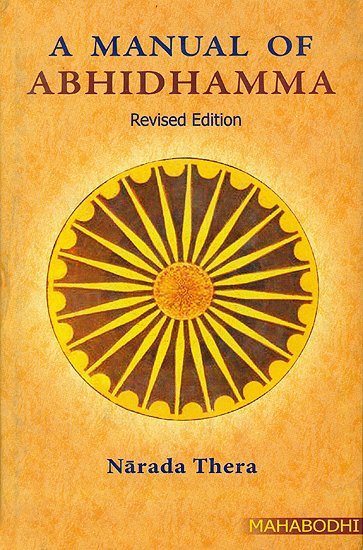A Manual of Abhidhamma
by Nārada Thera | 80,494 words | ISBN-13: 9789380336510
In the Abhidhammattha Sangaha there is a brief exposition of the Law of Dependent Origination, followed by a descriptive account of the Causal Relations that finds no parallel in any other philosophy. Edited in the original Pali Text with English Translation and Explanatory Notes by Narada Maha Thera....
§ 9.
Sabbattha' pi pan ettha anitthe ārammane akusalavipākān' eva pañcaviññānasampaticchanasantīranatadārammanāni, itthe kusalavipākani, ati-itthe pana somanassasahagatān' eva santīranatadārammanāni.
Tattha' pi somanassasahagatakriyājavanāvasāne somanassasahagatān' eva tadārammanāni bhavanti. Upekkhāsahagatakriyā javanāvasāne ca upekkhāsahagatān' eva honti.
Domanassasahagatajavanāvasāne ca pana tadārammanāni c' eva bhavangāni ca upekkhā sahagatān'eva bhavanti. Tasmā yadi somanassa-patisandhikassa domanassasahagatajavanāvasane tadārammanasambhavo natthi. Tadā yam kiñci paricitapubbam parittārammanamārabbha upekkhāsahagatasantīranam uppajjati. Tamanantaritvā bhavangapāto' va hotī' ti' pi vadanti ācariyā. Tathā kāmavacarajavanāvasāne kāmāyacarasattānam kāmāvacaradhammesv' eva ārammanabhūtesu tadārammanam icchantī' ti.
§ 10.
Kāme javanasattārammanānam niyame sati
Vibhūte ti mahante ca tadārammanamīritam.
Ayam' ettha Tadārammana Niyamo.
(translation)
§ 9.
Here, under all circumstances (i.e., in both sense-door and mind-door) when an object (12) is undesirable, the five sense-impressions, reception, investigation, retention (that arise) are immoral resultants. If desirable, they are moral resultants. If the object is extremely desirable, investigation and retention are accompanied by pleasure.
In this connection, at the end of functional javanas accompanied by pleasure, there arise retentive thought-moments also accompanied by pleasure. At the end of functional javanas, accompanied by equanimity, the retentive thought moments are also accompanied by equanimity.
But at the end of javanas, accompanied by displeasure, the retentive thought- moments and the bhavangas are also accompanied by indifference. Hence to one whose rebirth-consciousness is accompanied by pleasure, if, at the end of javanas, accompanied by displeasure, retentive thought-moments do not arise, then, there arises an investigating consciousness accompanied by indifference, hanging on to some sense-object with which one is familiar before. Immediately after, the teachers say there is subsidence into the life-continuum.
Likewise they expect retention at the end of Sense-sphere javanas to the Sense-sphere beings, only when Sense-sphere phenomena become objects.
§ 10.
Retention occurs, they say, in connection with 'clear' and 'very great' objects when there is certainty as regards the Sense-sphere javanas, beings, and objects.
Herein this is the procedure of retention.
Notes:-
12. Objects - ārammana
The desirability or undesirability of an object is determined not according to individual temperament, but according to its intrinsic nature. The resultant consciousness conditioned thereby is regarded as the effect of one's good or bad action.
The sight of the Buddha will perhaps be repulsive to a staunch heretic. His javana thoughts will naturally be unwholesome. But the passive wholesome resultant eye-consciousness, caused by a past good kamma, is a kusala vipāka. This vipāka is not conditioned by his will, but is an inevitable consequence. The javana process, on the contrary, is conditioned by his own will.
Again, for instance, the mere sight of excreta will be a source of delight to an ordinary dog. The object is generally undesirable and is a bad effect (akusala vipāka), but the javana process caused thereby will be wholesome to the dog. The accompanying feeling will also be pleasurable.
Although even an Arahat experiences an akusala vipāka at the sight of an undesirable object, his javana process will neither be wholesome nor unwholesome. The accompanying feeling will be one of equanimity.
Now, when an undesirable object is presented either through the mind-door or five sense-doors, the sense-impressions, reception, investigation, retention that occur in the respective thought-processes, are all bad effects (akusala vipākas). The accompanying feeling is invariably upekkhā, except in the case of body-impression which is dukkha. These thought-moments are the inevitable results of past bad actions.
If the presented object is desirable, then the afore-said thought-moments are all good effects (kusala vipākas). Here too the accompanying feeling is upekkhā, except in the case of body-impression which is sukha. All these thought-moments are the results of past good actions.
When the object is extremely desirable, the feeling of the santīrana moment differs. Instead of upekkhā it is somanassa.
The tadārammanas followed by Sense sphere functional javanas, accompanied by pleasure, are also associated with a similar feeling. Likewise the upekkhā javanas are followed by upekkhā tadārammanas.
As a rule the preceding javanas and the subsequent tadārammanas possess a similar feeling. Somanassa is followed by somanassa, and upekkhā by upekkhā.
What happens when the javanas are accompanied by domanassa as there are no domanassa tadārammanas?
If the rebirth-consciousness (patisandhi-citta) of the person is accompanied by somanassa, then when javanas are accompanied by domanassa, the tadārammanas, if they occur, will be accompanied by equanimity (upekkhā-sahagata), but if tadārammanas do not occur, then an adventitious upekkhā santīrana, without any special function, will intervene for one moment. This adventitious thought-moment is technically termed āgantukabhavanga. Usually the object of the javanas and that of the tadārammanas are identical. But in this particular case the objects differ. The object of this santīrana is another kāmāvacara object with which one is familiar in the course of one's life. This object is termed paritta (smaller or lesser) in comparison with the higher rūpa, arūpa and lokuttara objects.
If, on the other hand, the rebirth-consciousness is not associated with somanassa, then the tadārammanas therein become upekhā as are the bhavangas that follow.
It should be noted that tadārammanas occur only at the end of kāmāvacara javanas, only to kāmāvacara beings, and only in connection with kāmāvacara objects, which are either 'very intense' or 'clear.'
